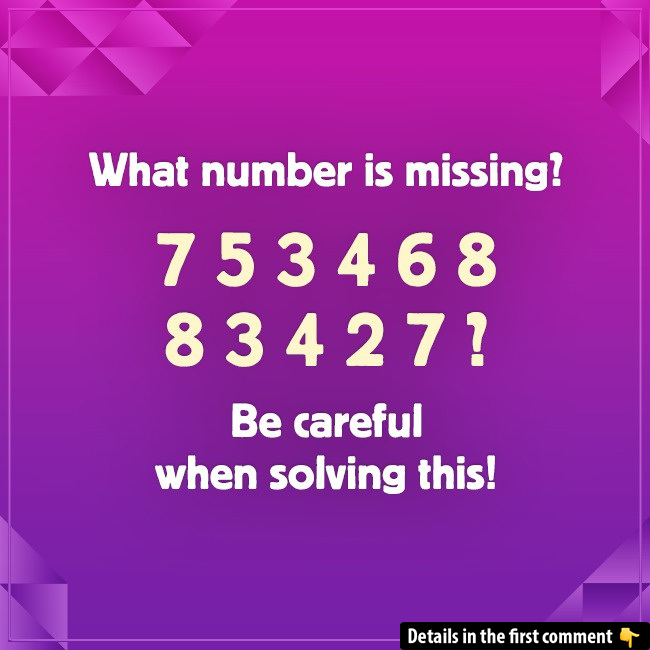Let’s face it—everyone loves a good challenge. And nothing beats the satisfaction of solving a puzzle that, at first glance, seems easy… until it’s not. Welcome to our latest brain teaser where your goal is to find the missing number that makes two rows of numbers add up to the exact same total. Sounds simple, right? Think again.
This isn’t just about crunching numbers—it’s about spotting patterns, avoiding mental traps, and thinking with precision. So grab a pen, clear your mind, and get ready to crack the code. Let’s walk through this step by step.

The Puzzle at Hand: Can You Find the Missing Number?
Here’s what you’re working with:
Top Row: 7, 5, 3, 4, 6, 8
Bottom Row: 8, 3, 4, 2, 7, x
Your task? Determine what number x must be so that the sum of the bottom row equals the top row.
At first glance, you might be tempted to guess. But if you really want to flex your logic muscles, it’s all about method, not luck.
Video: Clear your mind and dive into these light and cheerful brain games!
The Most Common Mistakes (And How to Avoid Them)
Before we dive into the solution, let’s talk about where people often go wrong:
- Miscalculating the total: It’s easy to add incorrectly when you’re rushing.
- Forgetting the goal: The trick is to balance both rows, not just solve a math equation in isolation.
- Guessing without logic: Trying numbers at random might eventually work—but it won’t sharpen your brain.
These errors come from either moving too fast or skipping steps. Let’s slow down and work through this logically.
Step One: Add Up the Top Row
Let’s get the total of the top row:
7 + 5 = 12
12 + 3 = 15
15 + 4 = 19
19 + 6 = 25
25 + 8 = 33
So, the top row adds up to 33.
Step Two: Add the Known Numbers in the Bottom Row

Now let’s total the five known numbers in the bottom row:
8 + 3 = 11
11 + 4 = 15
15 + 2 = 17
17 + 7 = 24
So, the known part of the bottom row is 24.
Step Three: Set Up the Equation
Now it’s just basic algebra. We want the total of the bottom row to match the top row’s total (33). That gives us:
24 + x = 33
Solve for x:
x = 33 – 24
x = 9
Boom. The missing number is 9.

Why This Puzzle Works So Well
It’s not about advanced math—it’s about paying attention to detail. You don’t need a calculator or a math degree. You just need patience, a clear head, and the willingness to work through a few simple steps.
This puzzle reinforces key skills:
- Basic arithmetic
- Equation setup
- Logical thinking
- Avoiding assumptions
It’s the kind of challenge that trains your brain to slow down and think clearly. And in a world of fast scrolling and instant answers, that’s powerful.
Real-World Application: Math Is Everywhere
You might be wondering, “So what? It’s just a puzzle.” But here’s the thing—problems like this one aren’t just mental games. They mirror real-life thinking.
Balancing a budget? You’re adding and subtracting to match totals.
Cooking dinner for guests? You’re adjusting recipes and measuring ingredients.
Planning a trip? You’re calculating costs, travel times, and making things line up.
Solving this puzzle may seem small, but it practices the kind of critical thinking you use every day—without even realizing it.
Let’s Talk Strategy: Did You Spot It Right Away?
Now that you know the answer, let’s flip the script. Did you:
- See the pattern right off the bat?
- Get stuck on one step?
- Try guessing and double-checking your answer?
It’s all part of the fun. Everyone approaches puzzles differently. What matters most is that you gave it a shot—and learned something from the process.
Ready for More? Keep That Brain in Shape
Video: Can You Solve These 35 Mind-Bending Puzzles in 10 Minutes?
If this puzzle got your brain buzzing, don’t stop now. Challenges like this one are a fantastic way to keep your mind sharp and engaged.
And hey, puzzles are proven to boost memory, improve focus, and even reduce stress. So really, this is self-care disguised as math.
Conclusion: The Beauty of Simple Logic
At the end of the day, this puzzle is more than just a numbers game. It’s a reminder that sometimes, the solution is right in front of us—we just have to look closely and think clearly.
You didn’t need fancy formulas. Just a few numbers, some focus, and a bit of logical thinking. And just like that, you cracked the code.
The missing number was 9—but the real win was proving to yourself that you could find it. Keep puzzling, keep thinking, and keep challenging your mind. You’ve got this.


